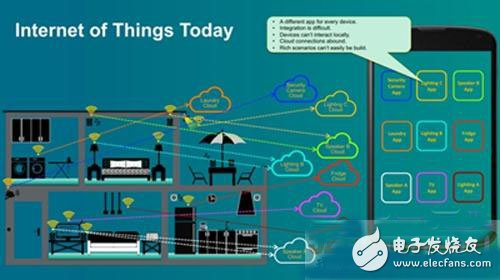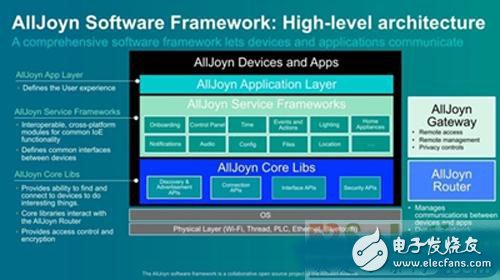In the era of the Internet of Things, wireless connectivity has become a basic requirement. From various alliances and scientific research institutions to major chip manufacturers and equipment manufacturers, they are striving to cite a technical agreement that is conducive to their own development and more widely accepted and supported by other manufacturers. From the recent Bluetooth conference, Bluetooth 4.2 will be compatible with WiFi. Before Qualcomm announced its participation in the Thread Alliance, it triggered the AllSeen and Thread cooperation speculation, and the WiFi Alliance released the proximity sensing technology Wi-Fi Aware, WiFi Direct, and the rise of Bluetooth Beacon technology. The Internet of Things connection technology is experiencing the most intense period from the princes to the unification of the world. From various alliances and scientific research institutions to major chip manufacturers and equipment manufacturers, they are striving to cite a technical agreement that is conducive to their own development and more widely accepted and supported by other manufacturers. From the recent Bluetooth conference, Bluetooth 4.2 will be compatible with Wi-Fi. Before Qualcomm announced its participation in the Thread Alliance, it triggered the AllSeen and Thread cooperation speculation, and the Wi-Fi Alliance released proximity-aware Wi-Fi Aware, Wi-Fi Direct, and With the rise of Bluetooth Beacon technology, the Internet of Things connection technology is experiencing the most intense period from the princes to the unification of the world. The Internet of Things involves short-range, long-distance, and various innovative applications. It raises the demand for ad hoc networks, proximity sensing, P2P transmission, and IPv6 support, and promotes the continuous development of wireless technologies. The new wireless technology also makes the form of IoT applications more diverse, from industrial applications, smart homes, to payments, retail, social, transportation, etc., covering almost every aspect of production and life. Below we will compare the development of several mainstream protocols, AllJoyn and ZigBee, Bluetooth, Wi-Fi and Thread, from two aspects of application and technical architecture. Wi-Fi: evolution to point-to-point direct and proximity sensing Wi-Fi is one of the most widely used wireless technologies in the world. It has a long transmission distance and high transmission speed, but its power consumption and network connection have always been a threshold for its entry into the Internet of Things. While chip vendors are introducing low-power Wi-Fi, the Wi-Fi Alliance has introduced Wi-Fi Direct and Wi-Fi Aware standards to provide one-to-one connectivity. Wi-Fi Direct is a standard released by the Wi-Fi Alliance in 2010 that allows devices on a wireless network to connect to each other without a wireless router, supporting a pair of connected devices and supporting all Wi-Fi devices from 11a/b /g to 11n. It is similar to Bluetooth technology, but it is better in terms of transmission speed and transmission distance. The disadvantage is that power consumption is still higher than Bluetooth. Allows two devices that are compatible with the standard to quickly connect together for photo and video sharing. The Wi-Fi Aware technology launched this year is more targeted at IoT applications. In an environment where there is no wireless network connection, it can explore other devices, applications or related information in the vicinity, and has features such as low energy consumption, always online, instant local, and multiple applications, similar to Bluetooth Beacon. ZigBee: Evolution of IP networking and application protocol convergence to IPv6 ZigBee has been favored in the smart home field due to its low complexity, self-organizing network, high security and low power consumption. This year, it released ZigBee 3.0, which comprehensively integrated the previous ZigBee Pro application specifications, including home automation, building automation, LED lighting, medical care, retail, smart energy and other aspects. The ZigBee Alliance and another important IoT technology alliance, the Thread Group, will also negotiate the application of the ZigBee application layer protocol on the Thread network. Bluetooth: Evolution to rate and 1-to-multiple transmission Bluetooth upgrade from version 1.0 to the latest version 4.2 enhances the Internet of Things, especially for home applications, and supports low-power wireless personal area network technology based on IPv6 protocol. The transmission rate is greatly improved under low power consumption without existing hardware. Update, only a firmware upgrade is supported. On the other hand, the Smart Mesh technology introduced by Bluetooth realizes the standardized Mesh network function and improves the shortage of networking. Bluetooth Beacon locks indoor proximity sensing applications, including indoor navigation, mobile payments, in-store shopping guides, and traffic analysis. Through the low-power Bluetooth technology, the Beacon base station creates a signal area. When the device enters the area, the corresponding application will prompt the user whether to access the signal network. Beacon base station has accelerometer, flash memory, ARM architecture processor and Bluetooth module. Its power consumption is very low. A giant battery can provide base station with about 2 years of battery life. Thread: Want to get through multiple protocols The emerging Thread Alliance is an Internet of Things alliance initiated by Google's NEST. The Thread standard is a derivative protocol based on the transformation of ZigBee's basic components. Not long ago, version 1.0 was released. The alliance said that Thread is a network layer protocol and application. Layer-independent, it is designed to work with or provide support for different application layer protocols. Future Thread may have opportunities to work with the AllSeen Alliance. However, the Thread threshold is higher. Except for ZigBee, the underlying protocol (802.15.4) is different from Wi-Fi (802.11b) and Bluetooth (802.15.1) and requires a device to replace the chip. AllJoyn: belongs to the software framework and implements interconnection at the application layer. The AllSeen Alliance is a collaborative project organization under the Linux Foundation that promotes cross-industry alliances for IoT applications and innovation. AllJoyn is an open source project led by Qualcomm, mainly for short-range wireless transmission, positioning and peer-to-peer file transmission via Wi-Fi or Bluetooth technology, and donated to the AllSeen Alliance in 2013. As an important member of the AllSeen Alliance, Qualcomm continues to tighten its layout on the Internet of Things. At the Maker Seminar held in the "Intellectual Reality of the Future", Qualcomm and AllSeen Alliance Chairman Xue Guodong introduced Qualcomm's latest intelligent connectivity solution - QCA401X Wi-Fi system-on-chip integrated with AllJoyn software framework. And the AllJoyn open source architecture. AllJoyn is an open source software framework that is independent of the operating system, development language, and communication protocols. It is suitable for all HLOS advanced operating systems such as Microsoft Windows, Linux, iOS and Android, as well as an embedded RTOS operating system with extremely limited memory and processing capabilities. It solves the problem in heterogeneous distributed systems and is called "Neutral platform." AllJoyn is characterized by its open source flexibility and its application layer, independent of the transport layer. The AllJoyn framework runs on the local network, eliminating the need to connect to nearby devices through the cloud, ensuring that applications and devices talk to each other directly, quickly, efficiently, and securely. Even without an Internet connection, devices can be interconnected; When connecting to the cloud remotely, connect to the Internet through the AllJoyn Gateway Proxy to reduce the number of devices connected to the Internet. AllJoyn physical layer supports Wi-Fi, Thread, PLC, Ethernet, Bluetooth, and solves the problem of Wi-Fi's ad hoc network. Later, it may expand more other protocols, whether it can really dominate the application layer. Wait and see. The problem facing the Internet of Things: With more and more smart home appliances and intelligent hardware products, devices cannot be interconnected, which will cause each device to install an APP on the mobile phone and correspond to a device cloud. In this way, technology has not only simplified life, but has added new complexity, and it is not convenient to create rich scenes. Devices across brands, categories, and operating systems cannot communicate with each other and cannot fully reflect IoT intelligence. AllJoyn Software Architecture An application layer that defines the user experience, an interoperable cross-platform module, and a service framework layer that defines a common interface between devices, and a core library layer that provides discovery and connectivity capabilities for devices. A high-quality supplier of Chinese sensors and accessories, using high-quality alloy steel and stainless steel materials, high precision, strong anti-eccentric load ability, easy to install, IP68, a wide range of sensors, a wide range of applications, and also produce Sensor accessories. Applicable to industry, floor Scales, truck scales, railway scales, etc. Load cell ,Sensor ,Waterproof load cell,Stainless steel load cell,Electronic load cell Ningbo Santwell Imp & Exp Co.,Ltd , https://www.santwell.com

